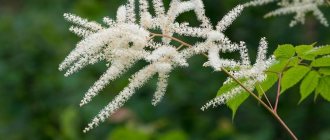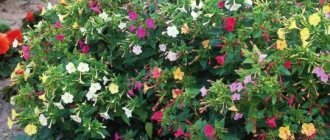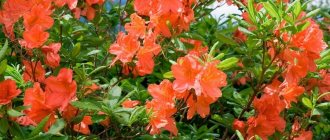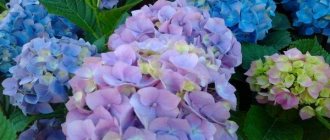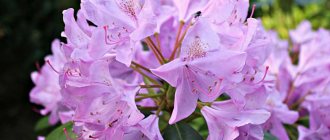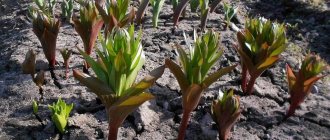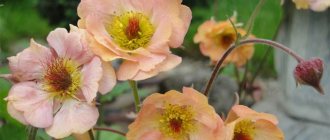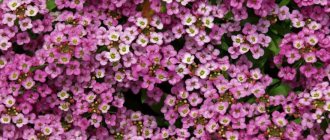Rhododendron is a stunningly beautiful plant, the numerous varieties of which delight the eye with a palette of colors and a variety of shapes. However, many gardeners are convinced that this crop is not so easy to grow anywhere except in countries with a warm tropical climate. Nevertheless, in central Russia it is very possible to become the owner of an exotic shrub or tree. That’s why it’s so important to know the varieties of rhododendrons for the Moscow region with photos and names and the features of plant agricultural technology for this region.
Rhododendrons in the Moscow region planting and care
Unsurpassed flowering shrubs will be the best choice for garden decoration. They can hide an unsightly corner with a luxurious crown or become a wonderful frame for the facade of a house. The many-sided azaleas are especially beautiful, delighting anyone who meets them. Residents of the South of Russia can safely plant such plants and take minimal care of them. But what about in the middle zone? Caring for exotics there is much more difficult, and cultivation can be radically different. In this article we will tell you how to grow rhododendrons in the Moscow region: planting and care, key points of agricultural technology, reproduction. This material will allow you to choose a suitable cultivar, which, with the right agricultural technology, will delight you with lush flowering even in harsh climates.
Rhododendron: origin, description, photo
Rhododendron is a shrub from the heather family. Less commonly, the plant reaches the size of a tree. The name comes from two words that are translated from Greek as “rose tree”. The delicate inflorescences really look like roses. Wild species are found in most parts of the world, but are mostly concentrated in the Northern Hemisphere - China, Southeast Asia, and the Himalayas.
Their appearance also changes depending on their natural habitat. Shrubs live in the undergrowth and valleys, creeping varieties grow on mountain screes, and in open coastal areas you can find real giants, the height of which reaches 5-25 m. The flowers differ in the color of the petals, the shape of the corolla and the size. Some types have flowers over 20 cm in size.
This is interesting! In addition to decorative landscaping, rhododendron has found application in medicine and perfumery. Extracts are included in medications for epilepsy and heart drops.
Deciduous cover can be annual, biennial or perennial, i.e. deciduous or evergreen. The plates differ in shape and size. They can be sessile or petiolate, whole or with serrated edges. The leaves are often oval, with a small edge on the surface.
The blossoming of the rose tree amazes with its splendor. The buds, collected in large brushes or scutes, have a slightly asymmetrical corolla. The color of the petals is so varied that even an experienced gardener will find a specimen to his liking. After the flowers wither, multi-seeded boxes with five leaves are tied. Seeds that look like sticks ripen inside. The root system is fibrous, lies in the upper layers of the soil, growth is slow. It propagates both generatively (seed) and vegetatively - by cuttings, layering, and dividing the rhizome. This bush lives for over 20 years.
Know! Most members of the genus rhododendron are poisonous. All parts of the bush contain a plant neurotoxin that depresses the central nervous system.
Origin, natural habitat
Origin, natural habitat of rhododendron in the Ural mountains
Rhododendrons are the name of a genus that includes many species of deciduous, semi-evergreen and evergreen shrubs and trees.
To create the most favorable environment for development, it is worth remembering their habitat. The geography of distribution is quite wide. These amazing shrubs prefer places with high humidity - the coasts of seas, oceans, and large rivers. You can meet them in semi-shaded areas or on the northern slopes of the mountains. The soil in the growing areas is acidic, rich in nutrients and well permeable to moisture.
The best varieties of rhododendron for the Moscow region
It is not surprising that such diversity attracted the attention of breeders. Having selected one of the local species, the British began to send botanical expeditions to Asia. Thanks to botanist-researcher George Forest, over 300 wild varieties were discovered in Southeast Asia, which formed the basis for selection. Since the beginning of the 19th century, the developments of scientists have made it possible to develop over 3 thousand garden cultivars.
Rhododendrons are most often used in ornamental gardening in regions with a temperate continental climate:
- Ledebura;
- katevbinsky;
- Smirnova;
- golden;
- Schlippenbach;
- Japanese;
- short-fruited;
- Daurian;
- Canadian.
Let's take a closer look at their main characteristics and popular varieties.
Ledebura, or maral, grows in the forests of Siberia, Altai and Mongolia. It is a semi-evergreen upright bush 50-200 cm high. Shiny small leaves are covered with small scales or edges. They overwinter and are replaced after flowering, which occurs in March and repeats in September. The corollas are bell-shaped, painted in pink-violet shades. The flowers are asymmetrical with long pink stamens. Resistant to temperatures down to minus 32⁰C.
Daursky. Outwardly, it is difficult to distinguish it from the maralnik. The leaves do not overwinter, but fall off with the onset of autumn. Decorative appearance occurs between the end of April and mid-June. It blooms for about 20 days. The corollas are light pink with a purple tint, funnel-bell-shaped, 2-4 cm. It grows in the territory located east of the Altai Range - Eastern Siberia, the Far East, Korea, Japan, Manchuria. The second name is wild rosemary. The seeds have high germination capacity and are frost-resistant. The cultivars are more stocky with purple flowers. Its frost resistance is much lower than that of botanical wild rosemary.
Know! Daurian wild rosemary, unlike its marsh relative, contains a much smaller amount of essential oils, so it does not cause headaches. Used in medicine and perfumery.
Katevbinsky. Formed the basis for most frost-resistant evergreen hybrids. Grows in the forests of North America. The height of the spreading crown is 2-4 m. The leaves are large, elliptical, length 10-15 cm, width 3-5 cm. The surface of the plate is dark green, glossy, with pronounced veins, the lower part is pale. The corollas are bell-shaped, colored lilac or white, sometimes with yellow-green specks. The flower size is 5-6 cm, there is no smell.
Decorative for a month at the end of spring or beginning of summer. Several compact hybrids with white and lavender speckled petals have been developed - Catawbiense Album, Catawbiense Boursault, Catawbiense Grandiflorum, Nova Zembla, Alfred. Life expectancy is about 100 years.
Smirnova. A dense evergreen bush 1-1.5 m tall. The leaves are large, elongated-elliptical, shiny on top and with dense white pubescence in the lower part of the blade. Length 10-15 cm, width 2.5-4 cm. Corollas are purple-pink, funnel-shaped, up to 7 cm, dense inflorescence. Inside there are 10 pubescent stamens and a bare pistil. The petals have yellow specks. Grows in Turkey on high mountain slopes. Used for hybridization of cold-resistant varieties. Varieties - Dorothy, Laika, Gabriel.
Kashkara, or golden rhododendron, lives in Siberia and the Far East, often forming impenetrable thickets. Yellow flowers 4-5 cm in size are collected in large umbrellas. Blooms in early summer. The leaves are dense, small, evergreen. The growth rate is very slow, winter hardiness down to minus 26⁰C.
Know! Despite their unpretentiousness, low (up to 0.5 m) creeping kashkar bushes take root very difficultly outside their natural habitat.
Schlippenbach. One of the most luxurious deciduous rosewood species. The spreading crown, 1.5–1.8 m high, is topped with medium-sized leaves. Large fragrant flowers 7-8 cm appear in early May. The petals are pink or white, the inflorescence consists of 4-5 pieces.
Canadian. A low-growing compact shrub 0.7–0.9 m high. Found in the eastern part of North America. Small leaves are colored in greenish-blue tones. The flowers are collected in small shields of 3-7 pieces. The main range of petals is pink-violet and odorless.
Japanese. Grows in Southeast Asia. Widely used in Russia as one of the most decorative, unpretentious and frost-resistant. The average height of the highly branched crown is about 1.5 m. It blooms profusely at the end of May for 3-4 weeks. The corollas reach 6-8 cm, collected in lush inflorescences. They are colored salmon or red with a yellow spot. A lot of hybrids have been bred on its basis.
Short-fruited. An evergreen giant, 4–6 m tall. Habitat: Asia, Kuril Islands. The leaves are leathery, dense, large. The flowers are pink or white, collected in umbrella-shaped shields of 12-15 pieces. Blooms in mid-summer. The first budding occurs on the tree at the age of 18-20 years.
Hybrid rhododendron is a collection of various cultivars grown in the garden.
On a note! Among the mass of hybrids, give preference to samples of Finnish selection - Elvira, Micheli, Hague and the “Northern Lights” series.
Types and varieties of plants
Conventionally, rhododendrons are divided into annuals and perennials. There are two common types of shrubs in Russia: Sims rhododendron and blunt rhododendron. Many hybrid varieties have been bred on their basis.
Low-growing rhododendrons (Bel Canto, Aurora) have a hard time surviving cold winters.
Residents of the Moscow region grow cold-resistant plant varieties: Kamchatka, golden, alpine rose.
Varieties of rhododendrons according to flowering cycle:
- Deciduous . They grow well where the climate is moderately cold. Examples: Daurian, Japanese, Canadian.
- Evergreens . Plants shed their leaves once every 2 years. Among the evergreen varieties, Nova Zembla, Abraham Lincoln, and Alfred tolerate cold well.
- Semi-evergreen . Shrubs shed some of their leaves for the winter. Example: Ledebourg rhododendron.
Rhododendron in the Moscow region - growing features
The cultivation of exotics in the Moscow region has a lot of subtleties. Many varieties are used in culture, but not all of them are suitable for the harsh climate of the Moscow region. The weather in this region is very unstable - in winter temperatures can drop below 35⁰C, in summer the thermometer can show 40⁰C. The distribution of precipitation is also uneven.
Frosts leave the region in early May and arrive at the end of September. Due to such weather fluctuations, the Moscow region belongs to the risky farming zone. Accordingly, in order to grow a decent harvest or any exotic plant, a competent approach will be required. You need to select Asian seedlings based on the climatic characteristics of the region. Only frost-resistant cultivars are suitable for the Moscow region. Planting and caring for exotics will be described in detail below.
Planting rhododendron in the Moscow region
In order for the azalea to give you bright colors, you will have to work hard and find the right place for it. After all, proper planting is the key to plant health.
It is important to choose the right planting material. It is better to make a purchase in specialized garden centers or nurseries. The second option is preferable, because the young shoots have already adapted to the climatic conditions of the region.
A good seedling aged 2-4 years has many branches from the root collar. Its foliage is even and smooth, without signs of injury, drying out, or spots. A closed root system is welcome. The roots protruding from the earthen clod should be free of knots and signs of spoilage.
If the material was purchased in the fall, it can be buried in a shady corner of the garden and be sure to organize a winter shelter. A dry, ventilated basement will also help preserve the cuttings until spring. Storage temperature is about 12⁰C, watering is very rare, it is better to spray the seedlings.
Important! Avoid buying cuttings at markets or spontaneous fairs. The purchased specimen will easily turn out to be of a different variety and will die under improper growing conditions.
Choosing a landing site
You should choose a place for an exotic garden inhabitant based on its natural living conditions. This tactic allows you to minimize stress.
Exotics can be planted throughout the season, with the exception of flowering time. However, the best period will be early spring. Since in the wild, almost all exotics grow under the canopy of trees, such a neighborhood will only benefit them. But you need to choose neighbors for an Asian very selectively. If the neighbor’s root system is taprooted and goes deep into the soil, then the plant will feel comfortable.
Pine, apple, larch, pear, cherry, oak are suitable. Neighborhood with birch, linden, maple, elm, willow, and alder will have a bad effect on your green ward. These trees have fibrous roots that lie in the same layers as those of the Asian guest. In the struggle for space and food, both representatives of the flora may die.
Important! Planting near trees is possible only at a distance of half the projection of the tree crown.
A shaded area on the northern side of the garden during the daytime is ideal. It is important that groundwater does not lie close to the soil surface. In this case, it is necessary to organize drainage or plant on high beds. When planning to plant a plant near buildings, make sure that it does not end up in the area where snow falls from the roof. Try to avoid windy areas where there is minimal snow cover in winter.
Soil characteristics
For an Asian resident, the composition of the substrate is very important. The soil pH plays a huge role. For proper development and health, exotic requires an acidic environment in the range of 4.5-5.5. If the soil does not meet this characteristic, it should be acidified. The introduction of high-moor peat, sulfuric acid fertilizers and special heather soil is encouraged.
The substrate should be loose and well-permeable, nutritious. A mixture of loam, acidic (high-moor) peat and pine litter in equal parts will help to ensure such properties. Clay will make the soil denser and prevent it from spreading during watering and rain. Pine needles acidify the soil, maintaining an optimal pH level, making the substrate loose and permeable. Peat also has oxidizing properties and a high humus content.
Remember! If you use clay instead of loam, then its amount must be halved. To prepare the substrate, you should not use humus, manure, sawdust, ash, or black soil, as they alkalize the soil.
Preparing the plant for planting
To prepare a seedling for planting, it is enough to place its root system in a bucket of water until bubbles stop appearing on the surface. It is better to plant young plants in small holes in the shade. In 2-3 years they will be fully strengthened and will be ready to show themselves in all their glory in a larger area.
Landing technology
To avoid stagnation of water in the roots, it is recommended to plant bushes on high mounds or organize a drainage layer 15-20 cm high. It is made of crushed stone or broken brick. The rose tree will not need a hole that is too deep, because the root system is of a superficial type.
To plant, use the following algorithm:
- dig a hole measuring 60 by 60 cm and 40 cm deep;
- lay out a drainage layer;
- fill part of the hole with substrate so that the root collar is level with the soil;
- compact the earthen mixture and place the seedling in the hole, straighten the roots;
- add the required amount of substrate, tamp;
- water generously and mulch the tree trunk circle with peat, pine needles or oak leaves;
- If necessary, install temporary support.
Advice! To ensure rooting is successful, remove some of the inflorescences. This way, you stimulate the development of the root system. If planting on a hill, be sure to line the shaft with large stones. They will help keep the mound intact during watering and during the rainy season. This frame will harmoniously fit into the design of your garden.
Preparation of planting material and propagation
The health and flowering of the bush depends on the quality of planting material.
When purchasing, you need to focus on the following indicators:
- The leaves are green and clean. They should not be stained or damaged. If you take a plant that has a different color, or there is some damage, you can get problems with subsequent care. A plant with an unattractive appearance has most likely experienced some kind of stress, the consequences of which will not simply go away.
- Inspect the root collar. It should be neat, without damage. This will facilitate good adaptation to the new landing site.
In general, the plant should look healthy: it should not have drooping branches or leaves. If it is not possible to purchase an adult seedling, then you can grow rhododendron yourself.
This shrub is propagated in 2 ways:
- By cuttings.
- Sowing seeds.
When planted by seed, the seedlings are kept indoors for 3 winters. Flowering can be achieved after the 5th year of life. The time for setting buds will be affected by air temperature, plant variety, and substrate. The advantage of growing from seeds is the ability to control every stage of the seedling’s maturation, as well as the selection of the strongest specimens.
Seedlings are sown in late February or early March. The soil is pre-steamed. There should be no lime in it. Scatter the seed over the surface of the substrate without deepening it. Water immediately from a spray bottle, and then cover the container with glass or film.
In 2-3 weeks the first shoots will appear. The period for seed awakening depends on the variety and external conditions. Young shoots are very weak, and therefore it is better to water through a tray. There is no need to feed seedlings. When 2 leaves appear on the shoots, start picking. The seedlings are carefully scattered at a distance of 2 cm from each other.
Experts advise planting seedlings in small pots 3-5 cm in diameter in the autumn. The soil must be suitable for rhododendrons. River sand can be added to the mixture. Broken bricks are placed on the bottom of the container for drainage. Its layer should not exceed 1.5 cm. Young shoots are hidden from direct sunlight, the room is ventilated, and the soil is periodically moistened.
In the second year of growth of rhododendrons bred by seed, they are transplanted into larger containers - the diameter should be from 5 to 7 cm. The substrate is updated.
Its composition should be as follows:
- ½ sod.
- ¼ peat.
- ¼ sand.
- A small part of the litter made of pine needles.
After the planting procedure, the seedling is immediately fed with fertilizer for indoor plants. It is diluted with water so that the solution becomes very weak - 1-3%.
In summer, containers with young plants can be moved to the site. To do this, choose a suitable place and leave it to adapt to street conditions. In summer, fertilizing is applied - fertilizer for indoor plants 5%. In winter, rhododendron is returned indoors. The temperature in it should be 12-15°C.
If rhododendron varieties are large, then they should be transplanted into a larger container. In the third year of life, the seedlings are again sent to live in the garden for the summer, and indoors in the winter. In the 4th season, before the leaves begin to bloom on the seedling, it is planted in the garden.
You can also get rhododendron by cuttings. To do this, use planting material cut from annual shoots of the bush. Deciduous varieties are rooted with apical green cuttings (from May to June), and evergreen shrubs take root better with semi-lignified branches (late June).
But, regardless of the type of cuttings, you need to use root-forming stimulants:
- Succinic acid.
- Kornevin.
- Heteroauxin.
It is difficult to propagate rhododendron using this method. The probability of seedling survival is less than 100%.
Algorithm for propagating rhododendron by cuttings:
- Select the upper parts of the bush. Priority should be given to shoots with weak defoliation at the base.
- Cut cuttings no more than 8 cm.
- The lower leaves, as well as the tops, are cut off. 3 plates are cut in half to reduce the amount of evaporated moisture.
- Longitudinal cuts are made in the lower part.
- Dip the bottom of the cutting into a solution with a growth stimulator for 13 hours.
- Planted in a container with substrate.
Rooting of seedlings takes a long time - 4.5 months. Such young plantings must be grown in a mini-greenhouse or on a loggia at home. In spring, containers with seedlings are buried in the garden. In winter they bring it back into the house. They are moved to a permanent place of growth the next year.
Caring for rhododendron in the Moscow region
If the Asian guest was planted in compliance with agricultural technology, then it will require minimal care. Mulching can retain moisture, which the bush values so much, avoid the riot of weeds and protect the delicate roots from overheating. Weeding will have to be done exclusively by hand. This measure is necessary to protect surface roots from mechanical damage. Loosening the earth is unacceptable for the same reason.
Watering
The rose tree loves to drink, and not just plain water, but soft water. Rain or river water will be ideal for it, settled water is also suitable. To soften, add a couple of handfuls of peat a day before watering. The plant suffers greatly from lack of moisture. The first signal of “thirst” will be drooping foliage and loss of glossy shine. Watering is carried out frequently, but in small portions. This way, water will not stagnate near the roots. The soil should get wet by 20-30 cm. Our exotic ward loves spraying.
Important! Avoid exposing sprayed leaves to sunlight, otherwise burns will occur. It is better to carry out the procedure early in the morning or after sunset.
At the end of August, watering is reduced to a minimum. If this is not done, the bush will begin to produce side shoots and will not have time to prepare for winter. Autumn in the Moscow region can be full of rain or very dry. During the autumn drought, water in small portions, monitoring the turgor of the foliage.
Fertilizing
Azalea will gratefully accept feeding. There are many mineral complexes on sale designed specifically for these plants. Dilute it according to the instructions and apply during watering. Sucking Kemira-universal is no less effective. It is sold in granules, which should be scattered around the bush at the rate of 1-2 tablespoons for each specimen over 40 cm in height. In order not to disturb the acid balance of the soil, use superphosphate and salts of sulfuric or nitric acids - ammonium sulfate, potassium nitrate. The average application rate is 50 grams per square meter.
Having chosen a treat for your pet, remember that it should be added until the end of June, twice a month. Starting from July, fertilizing is prohibited. This measure will ensure the preparation of the bush for wintering, and not the growth of green mass.
Know! Wood ash solution should not be used as fertilizer. It will significantly reduce the acidity of the soil and cause chlorosis of the foliage.
What to do if the rhododendron is frozen
Often, rhododendrons in the Moscow region, even with winter shelter, suffer from frostbite. This happens for various reasons, but it can almost always be avoided with the help of proper plant care. If the disaster has already occurred and the bush is frozen, you need to immediately begin actions to save the plant:
- Affected shoots must be pruned back to healthy wood. This is true for most varieties, except for the small-leaved evergreen rhododendrons, which can regrow without pruning.
- Spraying the crown with warm water with the addition of Epin at the rate of 10 drops of the substance per 5 liters of water 2 - 3 times with an interval of 4 - 5 days helps a lot.
- The base of the plant should be watered with a solution of Kornevin or Heteroauxin.
- Be sure to shade the bush on the south and west sides.
- Adding acidifiers or nitrogen fertilizing to the soil will also help bring rhododendron back to life.
Following these recommendations should have a beneficial effect on the condition of the plant, provided that the rhododendron root system has not died. The main thing is that you should not rush and use all the remedies at the same time, otherwise this will further undermine the health of the weakened bush. Before trying a new method of resuscitating a damaged plant, you should wait 7-10 days after the previous one, observing the condition of the rhododendron.
Rhododendron pruning
Since the exotic bush forms a regular crown, it practically does not require pruning. It is carried out to sanitize and rejuvenate the tree. In early spring, before sap flow begins, shoots damaged during the winter are cut out. Branches more than 2-3 cm thick will require treatment with garden varnish. The composition will not allow infection to enter through an open wound. For rejuvenation, half of the shoots are cut off at a height of 40 cm. The second half is removed the next season. Corrective pruning, the purpose of which is to make the crown more compact, is carried out after flowering.
Watering
Young seedlings need daily morning or evening abundant watering. Each plant requires at least 5 liters of liquid. As it grows, moisturizing can be done every two days, increasing the volume of water to 10 liters. During the flowering period, add half a teaspoon of citric acid to a bucket of water, increase the frequency of watering and additionally spray the foliage.
Rhododendron does not tolerate drought well; drying out the soil can lead to damage to the roots and loss of leaves. The plant should be moistened in the morning or evening, and not during the day, to avoid burns.
The soil around the trunk must be loosened and cleared of weeds. Lack of oxygen leads to the death of young shoots. The substrate should be loosened carefully so as not to damage the root system, which is close to the surface.
How to propagate rhododendron in the Moscow region
Exotic propagates both by seeds and vegetatively. When sowing seeds, you will have to wait quite a long time for flowering - from 6 to 8 years.
Cultivating seedlings is not that difficult, but protecting young shoots from frost is unproductive. Therefore, in the Middle Zone, generative reproduction is used extremely rarely. If you want to try your hand and spend time, sow the seeds in small boxes. As a substrate, use leaf soil and sand in a ratio of 3:1.
Cover the crops with glass and place them in the light. Care consists of maintaining normal watering, eliminating stagnation of water and its lack. Plant the grown seedlings into separate containers and grow them throughout the year in a cool greenhouse. Next spring, plant them in a shady location. Always protect young shoots from frost.
An equally complex process is propagation by cuttings. Cuttings 7-8 cm long are cut from semi-lignified branches. Excess leaves are removed and the cut is soaked in a growth stimulator. For rooting, use the same substrate as for sowing. Within 3-4 months, the cuttings will take root in a small greenhouse. For the winter, the sprouts are brought into a bright, cool room, and in the spring they are taken out into the garden. It is possible to plant cuttings in a permanent place only after 2 years.
Obtaining layering is an ideal way to propagate a rose tree in the Moscow region. Young branches are buried in early spring into grooves 15 cm deep. The crown is tied vertically. Care is minimal - water and feed along with the mother liquor. Layers are separated in autumn or early spring and immediately planted in a permanent place.
Know! Deciduous species reproduce best with the help of layering.
Characteristics and description
Azalea Katevbinskaya is an evergreen shrub, one of the most vigorous and winter-hardy varieties. It grows 6-8 cm per year, and an adult plant can reach 2-3 meters in height. The dark green, leathery and shiny leaves are also impressive in size - they grow up to 15 cm long. The trunk may be dark gray or have a brown tint. The flowers look like wide (6 cm) bells of lilac or purple color with a yellow-red pattern. There can be up to 20 of them in an inflorescence. Hybrid forms of Katevbinskaya azalea boast crimson, purple, red, white, pink and blue flowers.
The root system of azalea is shallow - 30-40 cm. It develops mainly in litter and humus.
Deciduous and evergreen rhododendrons in the Moscow region, planting and care
Regardless of what type of cultivar you choose, deciduous or evergreen, following the rules of its cultivation will allow you to enjoy the decorative properties of the pink tree for a long time. Let's summarize a little about agricultural technology in the Moscow region:
- choose only frost-resistant varieties;
- Monitor the acidity of the substrate, its range is 4.5-5.5. If necessary, add peat and special fertilizers;
- carefully consider the choice of location and neighbors of the rose tree;
- do not add substances that alkalize the soil - ash, lime, organic matter, dolomite flour;
- mulch tree trunk circles with peat or pine litter;
- Weed by hand;
- water in small portions in a timely manner, spray;
- do not apply fertilizers in the second half of summer;
- be sure to provide drainage in the planting hole.
There are a few more nuances. After the buds wither, the inflorescences are carefully removed. The plant will not waste its energy on ripening the seeds, it will begin to prepare for the dormant period and accumulate strength.
On a note! In warm autumn, the bush can begin to grow shoots. Spraying with a 1% solution of potassium sulfate will help slow down the growth process.
To prevent evergreen bushes from being damaged by the spring sun, cover them with a double layer of burlap or spunbond. Monitor the presence of high snow cover in the area. Snow is the best shelter in a frosty winter.
Landing algorithm
The plant can be planted at any time of the year, except for flowering. Experienced gardeners agree that the best planting period is spring.
- Dig a hole with a depth and diameter of 45-50 cm. If the soil is clayey, then increase this size by 10-15 cm and lay drainage. Rhododendron loves a moist substrate, but does not tolerate stagnant water.
- Prepare Kornegin's solution. You can take any other root formation stimulator. This will help the plant take root better.
- Immerse the root part of the rhododendron in the solution for 5-10 minutes.
- Take out the bush and let it drain a little. Do not pour out the solution!
- Using the transfer method, squeezing the pot so that its walls lag behind the earthen clod, remove the plant. If the soil is compacted very strongly, then it is necessary to knead it slightly with your hands to allow the roots to grow, which was previously limited by the walls of the dish.
- Add ready-made soil and a little underbrush into the hole, if desired.
- Place a young seedling in the hole so that it is no lower or higher than ground level. For example, if a plant grows on a hill, moisture will flow to its base. If you bury it deeply, the water will stagnate.
- Cover with prepared soil, pressing it down. The root collar is left open.
- The solution in which the root system was soaked is watered over the seedling.
- Add peat moss around the plant.
- Mulching. To do this, take scorch or bark, which produces acid. This must be done to avoid overheating of the surface root system. In addition, this way you can retain moisture.
It is desirable that the place for the seedling to grow is suitable in terms of acidity and lighting. Transplanting an adult plant will be more difficult compared to a young seedling.
Pests and diseases
If agricultural practices are followed, the bushes are practically not exposed to various diseases and damage. Noticing drying of the leaves or the appearance of yellowness on the blades while maintaining the network of green veins, we can talk about chlorosis. The disease is caused by a violation of the acidity of the soil; the addition of iron supplements will help to overcome it.
Rust is a disease caused by a pathogenic fungus. It is manifested by the presence of bulges on the leaves, cracking and growing over time. The fungus will die after treatment with Bordeaux mixture.
Spotting is characterized by the appearance of small specks of various colors. As the mycelium of the pathogen grows, the degree of damage increases. Copper-containing preparations will stop the activity of the fungus. You can use fungicides, for example, Fitosporin.
Leaf swelling is also caused by a pathogenic fungus. It is determined by the appearance of spherical formations on the plate. The affected parts are removed and treated with a fungicide.
Various rots are also destroyed by Bordeaux mixture, the preparation "Hom", "Topaz". The mosaic virus manifests itself by yellowing of the leaf and the formation of characteristic angular spots of various colors on the surface. Infected copies are immediately destroyed.
Remember! Carrying out preventive treatment with Bordeaux mixture in spring and autumn will help reduce the risk of fungal diseases.
Azaleas have quite a lot of pests - shellless slugs, scale insects, mealybugs, aphids, weevils, spider mites. Systemic insecticides will destroy the horde of those who want to taste the greens. Use the drugs "Actellik", "Comfidor", "Intavir", "Karbofos". A soapy shower is also effective against aphids and mites; slugs are afraid of the aroma of bleach and prickly mulch. Rhododendron in garden design
Lush growth, replete with fragrant flowers, is a favorite tool of landscape designers. The bushes look great both as tapeworms and in an ensemble with other plants. Azalea will be an excellent decoration for the facade, framing an artificial pond, and will fit on a green lawn or in a rocky rock garden, on an alpine hill.
As neighbors, select decorative foliage plants - hosta, barberry, fern, low-growing conifers. Rosewood combines luxuriously with spring bulbous crops, peonies, and hydrangea.
Conclusion
As you can see, if you follow the planting rules and carefully care, rhododendron can grow in the Moscow region. A luxurious shrub will become the calling card of your garden plot and will evoke a lot of positive emotions.
